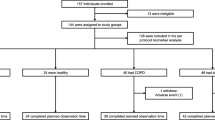Abstract
We conducted immunological examination of men 40–69 years of age working in the aluminum industry with occupational bronchopulmonary conditions of various etiologies (chronic non-obstructive bronchitis (CNB) and chronic obstructive pulmonary disease (COPD)). Persistent polyclonal immunosuppression was observed in both CNB (95% of cases) and COPD (85%). We recorded differences in the production of antibodies (ABs) depending on the form of bronchopulmonary conditions. We detected an increase in the levels of ABs against the S100, β1-AdrR, GFAP, AdrM proteins in CNB. We found a decrease in ABs against LuS and β2-GP I combined with an increase in ABs against GFAP in COPD. These changes in the content of visceral ABs are more likely to reflect destructive and inflammatory processes in the corresponding tissue structures and, consequently, different mechanisms of disease. Using discriminant analysis, we determined the most sensitive indicators in the CNB diagnosis: ABs against membrane antigens of lung tissue (LuM), ABs against the S100 protein, which is a regulator of cellular functions, and ABs against cytoplasmic antigens of neutrophils (ANCA). The data can help to improve the quality of diagnosis of occupational bronchopulmonary conditions in aluminum industry workers and provide the most optimal treatment options.
Similar content being viewed by others
REFERENCES
Beknazarova, G.M., Hygienic assessment of working conditions in various workshops of aluminum production and the impact of harmful production factors on the mucous membrane of the upper respiratory tract, Vestn. Avitseny, 2012, no. 2, p. 142.
Izmerov, N.F., Bukhtiyarov, I.V., Prokopenko, L.V., et al., Modern aspects of health profylactics and care of workers employed in aluminum smelters, Med. Truda Prom. Ekol., 2012, no. 11, p. 1.
Chebotarev, A.G. and Prokhorov, V.A., Working conditions and occupational morbidity of aluminum industry workers, Med. Truda Prom. Ekol., 2009, no. 2, p. 5.
Zaichik, A.Sh., Poletaev, A.B., and Churilov, L.P., Recognition of “own” and interaction with “own” as the main form of activity of the adaptive immune system, Vestn. S.-Peterb. Univ., Ser. 11: Med., 2013, no. 1, p. 6.
Notkins, A.L., New predictors of disease, Sci. Am., 2007, no. 3, p. 72.
Tauber, A.I., Reconceiving autoimmunity, J. Theor. Biol., 2014. https://doi.org/10.1016/j.jtbi.2014.05.29
Mal’sagova, A.A., Torchinov, A.M., Tsakhilova, S.G., et al., The clinical determination of the level of autoantibodies in pregnant women with preeclampsia, Vopr. Ginekol., Akush. Perinatol., 2017, vol. 16, no. 6, p. 81.
Mal’tsev, S.V., Poletaev, A.B., and Mansurova, G.Sh., Diagnostic and prognostic role of the determination of natural autoantibodies to renal antigens in the development of pyelonephritis in children, Pediatriya, 2007, vol. 86, no. 6, p. 60.
Moiseeva, O.M., Mitrofanova, L.B., Nakatseva, E.V., et al., Comparative analysis of the content of autoantibodies in serum for diagnostics of inflammatory myocardial diseases, Ter. Arkh., 2012, no. 9, p. 47.
Poletaev, A., Autoantibodies: serum content or profiles? in Physiologic Autoimmunity and Preventive Medicine, Sharjah: Bentham Science, 2013, p. 199.
Poletaev, A.B., Fiziologicheskaya immunologiya (estestvennye autoantitela i problemy nanomeditsiny) (Physiological Immunology (Natural Autoantibodies and Problems of Nanomedicine), Moscow: Miklosh, 2011.
Steiner, J., Walter, M., Glanz, W., et al., Increased prevalence of diverse N-methyl-D-aspartate glutamate receptor antibodies in patients with an initial diagnosis of schizophrenia: specific relevance of IgG NR1a antibodies for distinction from NN-methyl-D-aspartate glutamate receptor encephalitis, JAMA Psychiatry, 2013, vol. 70, no. 3, p. 271.
Poletaev, A.B., Molekulyarnaya dispanserizatsiya (novye podkhody k rannemu proyavleniyu patologicheskikh izmenenii v organizme cheloveka: Metodicheskie rekomendatsii dlya vrachei) (Molecular Clinical Examination (New Approaches to the Early Manifestation of Pathological Changes in the Human Organism: Recommendations for Physicians), Moscow: Immunkulus, 2014.
Meroni, P.L., De Angeles, V., and Tedesco, F., Future trends, in Autoantibodies, Amsterdam: Elsevier, 2007, p. 823.
Author information
Authors and Affiliations
Corresponding author
Additional information
Translated by I. Shipounova
Rights and permissions
About this article
Cite this article
Bodienkova, G.M., Boklazhenko, E.V. Content of Visceral Antibodies Depending on the Form of Bronchopulmonary Pathology in Aluminum Industry Workers. Hum Physiol 45, 196–201 (2019). https://doi.org/10.1134/S0362119719020026
Received:
Revised:
Accepted:
Published:
Issue Date:
DOI: https://doi.org/10.1134/S0362119719020026




